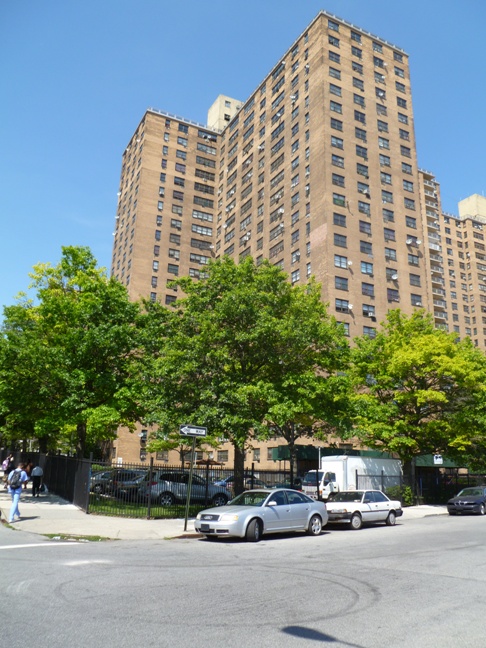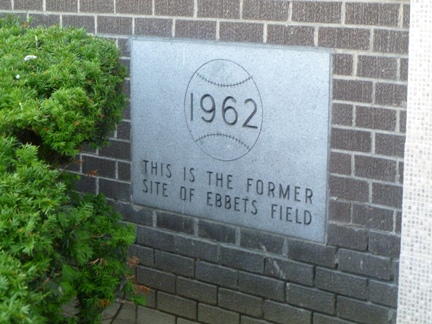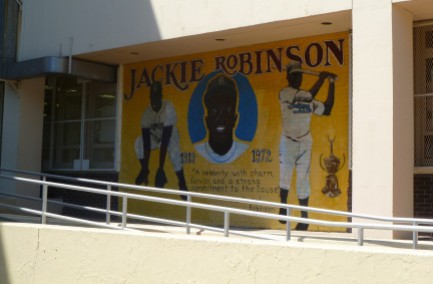A Visit to Ebbets Field
There is no park that has inspired as much—for lack of a better term—hagiography as Ebbets Field. It remains as not only a symbol of the Brooklyn Dodgers themselves—and Jackie Robinson as well—but also of Brooklyn in the post-war period. Few ballparks have inspired such reverence, especially in a relatively short period. Shea Stadium hosted the Mets just as long as Ebbets Field did the Dodgers, and had no shortage of great games, but few mourn for Shea as some do for the Dodgers.
(And perhaps no one mourns for Ebbets Field like Mets owner Fred Wilpon, who spearheaded Citi Field’s “Jackie Robinson Rotunda” modeled on the one at Ebbets Field. That a tribute to a team other than his own might seem completely absurd apparently never occurred to ol’ Fred.)
 |
| Where the Rotunda once stood |
In fact, in light of the hagiography surrounding the stadium, visiting its site, especially for a New Yorker—even a Yankee fan—almost feels like a Hajj, a trip one has to make to truly be complete as a baseball fan. All of this makes actually being at the Ebbets Field site all the stranger because it is, truthfully, underwhelming. But I guess we’re getting ahead of ourselves.
Until the 1913 season when Ebbets Field opened, replacing, among other things at the site, a garbage dump poetically, if graphically, known as “Pigtown” for both its stench and the animals which frequented it, the Dodgers played most of their games at Washington Park, located in Park Slope.
(Washington Park, like the Polo Grounds, actually refers to a number of stadiums in the same geographical area, whose history I’m not getting into just now, largely because I can’t get it sorted out. In any case, it is notable today mainly for still having a standing wall in Brooklyn, which is generally considered the oldest remaining piece of any baseball stadium.)
At the time of its opening, Ebbets Field held, depending on who you believe (or how you count) anywhere from 18,000 to 25,000. Whatever the capacity of the park, it did not include many members of the media: it was built without a press box, and would not have one until 1929.
The park was also notable for its strange dimensions, owing to the shape of the land purchased by Dodgers’ owner Charles Ebbets—which can still be easily seen when looking at the gridlines of modern Brooklyn. Though Yankee Stadium is more famous for its short right-field porch, the right field line at Ebbets Field was under 300 feet, and at least in its early days, the stadium had no screen or other feature to prevent short fly balls from becoming easy home runs. Meanwhile, until the park was gradually enclosed to increase capacity (a process that took place through the stadium’s second and third decades), left and center fields were cavernous, with some sources listing the distances as far as 460 feet.
 |
| Ebbets Field deserves a better marker |
Ebbets Field as it is often remembered in the popular imagination, with its large scoreboard in right field—topped by the Schaefer Beer sign, whose “h” and “e” would light up to reflect scoring decisions—did not take form until 1931, when renovations on the park were largely complete. The only major addition thereafter was light stands added prior to the 1938 season.
(The lights themselves, incidentally, still stand, albeit not in Brooklyn. After the park was demolished, they were moved to Randall’s Island, where they remain, formerly lighting Downing Stadium, and now the new Ichan Stadium. Although how much of the originals are extant is a reasonable question, one can say that the Ebbets Fields lights have cast their glow on athletes from Jackie Robinson to Pelé to Usain Bolt, which is rather a nice image.)
Of course, the reason so many people remember Ebbets Field in its Shaefer Beer/Hit-Sign-Win-Suit heyday was because of the sheer number of the World Series games played there. From 1947 until the Dodgers left town in 1957, Ebbets Field hosted 20 World Series games, an incredible number for an 11-year period.
Of course, all good things must come to an end, and after a dispute between Dodgers’ owner Walter O’Malley and “Power Broker” Robert Moses made it clear there would not be a new stadium to the former’s liking in New York, the Dodgers decamped for Los Angeles.
Ebbets Field remained standing until February of 1960, when it was demolished to make way for public housing. This brings us back to my visit to this site a couple of weeks ago. (Long-term readers will note that, unlike with the Polo Grounds, I was clever enough to make the trip out to Brooklyn in the summer, so I didn’t go while I was freezing.)
As I mentioned, even compared to the Polo Grounds site—which is no great shakes itself—the former Ebbets Field is pretty underwhelming. This is best reflected in the plaque, pictured on the left, which commemorates the site’s history. Although the plaque at the Polo Grounds is poorly maintained, it is at least placed at the approximate location of home plate and includes a brief history of the park. The Ebbets Field plaque is instead located, vaguely, in what was center field. Of course, as you can see, the sign makes no mention of this, or even the dates of the park.
 |
| This mural has the right idea |
In fact, if one walks to the former site of the Ebbets Field rotunda, there is no indication at all that—within my father’s lifetime—you could walk here and purchase a ticket to see the stadium where Jackie Robinson made his debut, where the first televised baseball game took place. As a New Yorker and a baseball fan, I was doubly disappointed.
It is only fair I point out that the surrounding neighborhood does a better job honoring the site. Across the street from the Ebbets Field Houses is a building which houses schools named for both Jackie Robinson and the stadium itself, and includes—as pictured—a mural of Jackie.
Nonetheless, one expects in light of the veritable Cult of Ebbets Field associated with it, there to be more at the site. Perhaps in the future this oversight will be corrected, but for now one must rely on the memories and knowledge you already possess to make a visit to the Ebbets Field site a memorable one.
Of course, all good things must come to an end, and after a dispute between Dodgers’ owner Walter O’Malley and “Power Broker” Robert Moses made it clear there would not be a new stadium to the former’s liking in New York, the Dodgers decamped for Los Angeles.
… the vertable Cult of Ebbetts Field …
—-
“Cult” is perhaps an excellent word choice. For the entirety of the glorious (for the Dodgers) 1950s, this hallowed stadium that was home to this great team never attracted more than an average of 16,235 for any season. In the Dodgers’ last year in Brooklyn, they drew 13,354 a game.
This year the Pittsburgh Pirates are drawing 24,031 and are next to last in the NL.
Think about that.
And don’t blame O’Malley.
While on a family vacation to New York several years ago, I had the pleasure of finding the old Ebbets Field site. A couple of impressions that have stayed with me are 1. once you get to the Botanical Gardens off Flatbush Avenue, there is a bit of a maze of streets to get to the rotunda area (McKeever Place and Sullivan Place), and 2. there is a fairly good sized incline that runs along where the center to rightfield wall would have been on Bedford Avenue. They had to have transported an awful lot of fill to make the field level. And Richard, you are right about the lack of signage- aside from the school, you could likely be unaware of the fact that there was once a ballpark there.
Thank you for the great article and pictures!
“Cult” is perhaps an excellent word choice. For the entirety of the glorious (for the Dodgers) 1950s, this hallowed stadium that was home to this great team never attracted more than an average of 16,235 for any season. In the Dodgers’ last year in Brooklyn, they drew 13,354 a game.
This is really more a reflection of increased attendance across baseball in the modern age than it is anything about the Dodgers. From 1939 through 1956, they ranked first in attendance 10 times, and second five others.
I have little doubt the Dodgers had stayed in Brooklyn—either in a new stadium or in Ebbets Field, they would be drawing at a rate comparable to other franchises.
Richard,
That may be true, but the larger point is, they had slipped from drawing 21,000 in 1949 to where this “beloved” team in its world championship season in 1955, drew 13,423 a game. Think about that. The championship got them a 2,300 per game bump the next year, but in 1957 they were back down under even that 1955 figure.
Bill James wrote about this in the original historical abstract and thought maybe he should have called the article “sympathy for the devil,” but if you look at it from O’Malley’s perspective, he had given Brooklyn great baseball for a decade but it sure looked like nobody there gave a s*** whether he pulled up his team and left.
If … if … if … but nobody was going to give O’Malley a stadium, and nobody was coming to Ebbetts Field. Should he have just stayed there? Why? He watched other teams pick up and move and do gangbusters at the gate (Milwaukee, Baltimore). He was just supposed to wait until fans got nostalgic for a stadium they didn’t want to come to? It took losing the Dodgers and Ebbetts Field for people to get nostalgic for the Dodgers and Ebbetts Field, conveniently forgetting they didn’t go and didn’t care when they had the chance.
“Don’t it always seem as though, that you don’t know what you’ve got till it’s gone. Replace paradise, put up a parking lot.”
Obviously, we can go back-and-forth on this point, and you’re hardly wrong that the Dodgers did not always draw in line with results. But in the five years prior to 1956—when the stadium battle really took off, and the Dodgers starting playing games in Newark as a partial protest aganist the stadium issues—the team ranked 2nd, 4th, 2nd, 1st and 1st in attendance.
Citing the raw numbers isn’t really meaningful; the Dodgers dropped from 21K in 1949 to 13K in ‘55 but every franchise (excluding the Braves, who shifted cities and therefore aren’t really comparable) lost attendance in those years. In ‘49, every team except Philly and Cincy drew at least 14K per game. In ‘55, no one except the Braves did. Attendance was just way down everywhere.
But the fact the Braves shifted cities IS comparable, because it showed there were new markets out there beyond the same old dozen where they’d been playing for 50 years, markets dying to support a team, and that if you moved to those markets you could possibly triple your gate receipts. And really, in those days there were few sources of revenue for owners other than gate receipts. There was probably piddling if any money coming from infant television and radio, probably next to no merchandise marketing … You made your money off selling tickets and Holy Cow! Look at the Braves!
The Dodgers may have been leading the league in average attendance but the trend wasn’t upward, was it? How long should O’Malley have waited, then, until it hit 12,000? 11,000? 10,000? And did I mention Holy Cow! Look at the Braves!? What am I sticking around THIS dump for?
To really get a feel for the Walter O’Malley – Robert Moses “fight,” you need to see the excellent HBO documentary, “The Ghosts of Flatbush.” The site where O’Malley wanted to buy the land on the cheap because it wasn’t being used is now being built up. On Google maps it still looks like a vacant lot. It was the corner of Atlantic & Flatbush at the end of the subway and the Long Island railroad. O’Malley was willing to build and pay for his own stadium as he did in Los Angeles. What owner will do that today without public money?
A couple of points. First, I think bucdaddy is making a good point. It was not just the possibility of huge profits elsewhere, but the fact that population movement and neighborhood decay was making staying in Ebbets Field ultimately ruinous. O’Malley was desperately trying to remain in Brooklyn but was stymied by Moses’s opposition. I think there was even talk about building a domed stadium at the site HEP3 mentions to which he expected to draw the Brooklyn emigres in Long Island, but again, Moses insisted on a Queens location.
On another issue, I don’t think the tribute to the Dodgers in the new Citifield is absurd. The Mets were, from inception, intended to be the heirs to the city’s NL clubs. Their colors were intentionally chosen to represent Giant Orange and Brooklyn Blue. So the reference to the continuity of NL baseball in NY is perfectly proper.
Actually, I wonder more about “Tal’s Hill” in Houston. I think it is a tribute to Crosley Field, but don’t know if there is any connection between the Astros and the Reds. If there isn’t, that feature never made sense to me.
The Dodgers drew only 1,033,000 in attendance in 1955, when they won their only World Series. New York teams today routinely draw 3-4 times as many. The 1955 Kansas City As, a terrible team, had an attendance of nearly 1.5 million, the first year they moved there. O’Maley should of course have left the Dodgers where they were, but his logic was that if they could draw barely a million fans when they won the Pennant and World Series, what were they going to draw five years later when (he thought) they would be a second division team? (He could not forsee their success in the 1960s in LA). Playing in a decaying, increasingly crime ridden neighborhood with no parking, in an obsolete ball park. New York City should obviously have helped O’Malley to build a new stadium, but Robert Moses was almost criminal in the obstacles he placed in O’Malley’s way- most recent historical studies of the move have shown that Rbt. Moses almost drove O’Malley out of NYC. By the way, a reporter went back to the site of Ebbets Field in the 1980s and says he saw two signs there: “Site of Ebbets Field,” and, nearby, “Ball Playing Prohibited.”
Of note–the cornerstone that sits at Ebbets Field apartments rests in the right field corner, almost on the spot where the Dodger bullpen was. The article says its in center field and that’s not accurate. Were the field stil there today, that cornerstopne is right where the stands ended and the scoreboard wall began.
I’d rather see the ballpark than that cornerstone…every time I visit that site….
Re: “Ebbets Field remained standing until February of 1960, when it was demolished to make way for public housing.”
Unlike the Polo Grounds, the apartment complex built on the site of Ebbets Field is not run by NYCHA (New York City Housing Authority) . Contrary to popular belief, Ebbets Field Apartments is NOT public housing; it is a privately owned and operated complex.